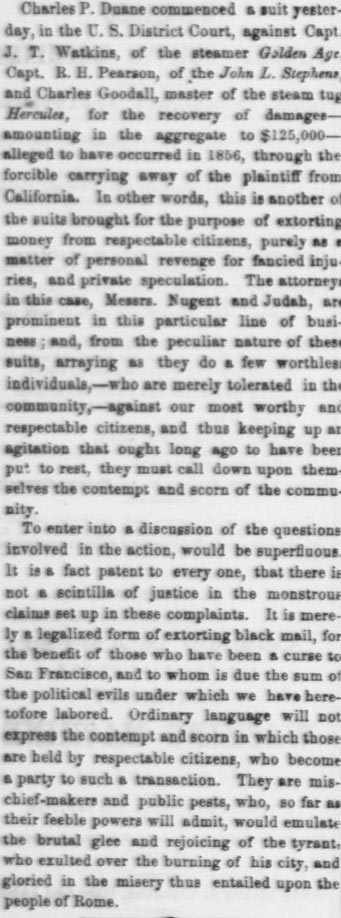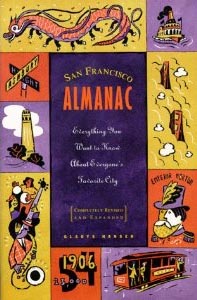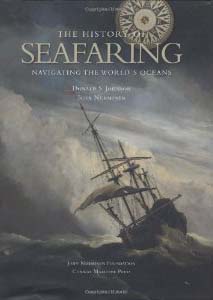Ship Captains in the Seaport of San Francisco: 1800s
December 22, 1824-1899
Charles Goodall came to San Francisco from Wales in 1859 at the age of 26.
Charles Goodall was founder of The Pacific Coast Steamship Company. Different dates are cited as the beginnings of the company: An article indicates they were going in and out of Monterey beginning in 1870; another indicates the company started in 1875; a third indicates September 1882 under the name Pacific Steamship Company).
This passenger and freight company was based on Beale Street in San Francisco. They shipped a variety of cargo such as vegetables, grain, lumber, coal and iron, and boasted modern, luxurious facilities for their passengers.
In 1870, the Pacific Coast Steamship Company constructed the wharf at Monterey for regular passenger and freight service.
In the early 1890s, the name Pacific Coast Steamship Company gained permanent resonance, until the demise of the company in 1936. The company travelled routes from Alaska to San Diego, and included stops in many ports along the west coast of the United States, Canada and Mexico. This was a large company that employed over two dozen ships.
This passenger and freight company was based on Beale Street in San Francisco. They shipped a variety of cargo such as vegetables, grain, lumber, coal and iron, and boasted modern, luxurious facilities for their passengers.
In 1870, the Pacific Coast Steamship Company constructed the wharf at Monterey for regular passenger and freight service.
In the early 1890s, the name Pacific Coast Steamship Company gained importance until the demise of the company in 1936. The Pacific Coast Steamship Company (PCSC) was founded in 1875 (a second listing indicates September 1882; another article indicates they were going in and out of Monterey in 1870) under the name Pacific Steamship Company).
This passenger and freight company was based on Beale Street in San Francisco. They shipped a variety of cargo such as vegetables, grain, lumber, coal and iron, and boasted modern, luxurious facilities for their passengers.
In 1870, the Pacific Coast Steamship Company constructed the wharf at Monterey for regular passenger and freight service.
In the early 1890s, the name Pacific Coast Steamship Company gained permanent resonance, until the demise of the company in 1936. The company travelled routes from Alaska to San Diego, and included stops in many ports along the west coast of the United States, Canada and Mexico. This was a large company that employed over two dozen ships.

Daily Alta California, August 15, 1862
THE DUANE SUIT.-The suit of Charles P. Duane against Charles Goodall, Master of the steamtug Hercules, is for $2,000 damages for the transportation of libellant on that tug, from the wharf to the stamer Golden Age, in June 1856, when he was exiled by the Vigilance Committee.
The amount claimed as damages was at first fixed at $25,000, but was afterwards reduced to $2,000. Under the decision in the case of Gallagher against the barque Yankee, Judge Hofman held that the vessel was not liable for the act of the Master in transporting an exile, so the judgment, if any, can only be against Capt. Goodall personally, and is not a lien upon the tug.
Oakland Tribune, August 2, 1889
OCEAN TRAVEL
PACIFIC COAST STEAMSHIP CO.
Dispatch steamers from San Francisco from San Francisco for ports in Alaska, 9 A.M., March 11, 26; April and May 10, 25; June and July 9, 14, 24, 29.
For British Columbia and Puget Sound ports 9 A.M., March 6, 11, 16, 21, 26, 31; April and May 5, 10, 25, 20, 25, 30.
For Eureka, Humboldt Bay, Wednesdays, 9 A.M.
For Mendocino, Fort Bragg, etc. - Mondays and Thursdays 4 P.M.
For Santa Ana, Los Angeles, and all way ports - Every fourth day 8 A.M.
For San Diego, stopping only at Los Angeles, Santa Barbara and San Luis Obispo - Every fourth day at 2 P.M.
For ports in Mexico - 25th of each month.
San Francisco Call, October 16, 1893
THE NEWBERN WRECK
She Is Slowly Settling Into the Ocean.
Divers Will Endeavor to Bring Up the Submerged Silver Bullion.
Redondo, Oct. 15. The Newbern's position remains unchanged. She is slowly going to pieces. The Coos Bay arrived on the scene this morning and has succeeded in saving considerable of the furnishings. Passengers with their baggage were transferred to the Corona and proceeded on their trip at noon. Divers will arrive to-morrow and endeavor to recover the $25,000 of bullion still in the hold.
Conveyances and excursion craft from Redondo visited the wreck. Many souvenirs were obtained, and everybody is smoking genuine imported Mexican cigars. The weather is clear and the sea is very calm. Had the whistling buoy, which was petitioned for by the Redondo Beach Company a year ago been received, this wreck would not have occurred. Such a buoy is absolutely necessary at this point.
NOT YET DECIDED.
No steps Taken Toward Putting on
Another Steamer.
Captain Charles Minor Goodall was seen by a Call reporter at his residence, in Oakland, last evening. He stated that his company had not yet determined what will be done in regard to putting on another boat in place of the Newbern. The company will hold a meeting today or tomorrow, when the matter will be discussed. Captain Goodall stated further that he did not know anything about the report that the North American Navigation Company intends to place the St. Paul on the route over which the Newbern sailed, but any action that her owners or charterers may take will affect his company, should it be decided to put on another boat to take the place of the lost steamer.
November 25, 1893, San Francisco Call
COOS BAY COAL.
A Big Mine Struck by Goodall & Perkins.
Large Quantities of the Fuel Being Brought Already to San Francisco by Steamer.
Goodall, Perkins & Co. have developed a coal mine which promises to add a million or more to their wealth. When they bought the mining and steamship property of the Oregon Coal and Navigation Company a few months since they also secured the Coffin Tract, a new coalfield on Coos Bay, for which they paid $30,000. Within four w eks from the date of the purchase an English syndicate, which had been prospecting on the land, offered Goodall, Perkins & Co. $300,000 cash and $200,000 stock in a $1,000,000 company for the tract, which sums were declined, and the firm opened the mine on its own account.
The first coal for export was taken out about three weeks ago. It turned cut to be the best coal ever uncovered at Coos Bay and sells here as fast as it is discharged. The steamers Arcata and Arago bring down 700 tons each trip and there is a twenty years' supply. "in sight."
The new coal development is important for the reason that it gives this city a fuel supply very much closer than any other source. A steam vessel from this port loading cargoes there saves about 1200 miles in distance over any of the coal loading ports on the Pacific Coast. Lower cost of transportation cannot help but lower the cost of coal to the consumer.
Nor is this coal find the only piece of good fortune for Goodall, Perkins & Co. They have again renewed their contract with the Oregon Improvement Company to manage the business of the Pacific Coast Steamship Company. Under this contract they receive a handsome commission on the gross earnings of the steamers.
August 12, 1897, San Francisco Call
LOST WHEN MOST NEEDED.
Goodall, Perkins &, Co. Find It Difficult to Replace the Mexico.
The following telegram was received by Goodall, Perkins & Co. from Nanaimo, B. C:
The Mexico started from Sitka at 9 a. m. on the 4th inst. Took the outside passage and arrived at Cape Chacon at midnight. Got under way again at 3 a. m. and at 4:20 a. m. struck a rock on the starboard bilge, supposed to be West Devil Rock, fourteen miles from Cape Chacon, The steamer filled very rapidly, and at 6:30 A. at. sank in eighty-five fathoms of water. All the passengers and crew were saved. Such baggage as was in the staterooms was also saved. Everything else was lost. Boats were left at Metlakahtla in charge of Rev. Mr. Duncan, head missionary on the Alaskan station. Captain Thomas and all passengers and crew came down on the City of Topeka.
The Mexico left the sound last month with a large party of Christian Endeavor excursionists and went as far as Dyea, where she landed a few miners, bound for Klondyke. Over 400 miners who had booked to leave on her on the return trip were awaiting her at Seattle, so Captain Thomas took the outside passage, or "the short cut home." It proved to be the long way around.
Goodall, Perkins & Co. are in a quandary over the loss of the steamer. A few months ago half their fleet was idle and now they cannot charter a vessel for love or money. As of last Tuesday night men worked on the City of Puebla getting her Puget Sound freight out and yesterday afternoon she sailed for Port Harford to bring up a load of grain. With her went forty longshoremen and forty more will be engaged at Port Harford. It is hoped ! to have the vessel loaded and back in San Francisco tonight In order that she may leave for Puget Sound ports some time tomorrow. The Oregon has to be hauled out of retirement and put on the Columbia River route to relieve the glut there, so the company has not a vessel available to take the place of the Mexico. Among those who were awaiting the arrival of the Mexico at Seattle is Sam Pond, son of ex-Mayor Pond. He is bound for the gold fields, and yesterday his father spent half a day trying to get him a passage on the City of Topeka. The latter goes only as far as Juneau, however, and the only way by which Dyea can be reached is by the George W. Elder, which leaves six days later.
"We will do everything in our power to straighten out matters," said Edwin Goodall yesterday: "but, such matters cannot be fixed up in a moment. If by any possible chance we can secure a steamer she will at once be sent up to take the Mexico's place. If we can't, we will have to do the best we can with the Elder and Topeka. The Mexico was partially insured."
There is just a chance that the Zealandia may be chartered from the Oceanic Steamship Company and put on the southern route. In that event the Corona would be sent north to replace the wrecked steamer.
The Mexico was built by the Dickies about ten years ago for a company trading in the Gulf of California. Captain John Bermingham superintended the building of the vessel, and be stuck so religiously to the terms of the contract that the builders lost at least $20,000 on the job.
About seven years ago, when on her way here from Nanaimo, B. C, she struck on a rock in the Gulf of Georgia and sank. She was afterward raised and brought to San Francisco, where she was thoroughly repaired. Since that time up to the present disaster her career was an uneventful one.
September 13, 1902, San Francisco Call
CHANGE OF MANAGEMENT OF STEAMSHIP COMPANY
Edwin Goodall Will Assume the Duties of His New Office on Thursday Next
The firm of Goodall, Perkins & Co. has retired from the active management of the Pacific Coast Steamship Company. Edwin Goodall, who has been elected the new president of the company, will assume his duties Thursday. Charles Miner Goodall will continue as a director. J. F. Lawless has been appointed manager of the company, with headquarters in this city.
Death of the Goodalls
Editor's Note: The following newspaper articles are confusing; it seems that the various Goodalls are mixed up as they have Charles Goodall dying on three separate occasions.
July 14, 1899, Los Angeles Herald
DEATH OF GOODALL
President of the Pacific Coast Shipping Concern
San Francisco. July 13. A cablegram was received here today announcing the death at Drycott, England, of Captain Charles Goodall of the firm of Goodall, Perkins & Co., the pioneer shipping firm of this coast and controlling the Pacific Coast Steamship Company, whose vessels ply between all the large large ports on the Pacific coast, including Alaska. Captain Goodall was about 75 years of age. A few years ago he married a comparatively young woman, and with his wife went to Europe. Reports received from England were to the effect that he had been declining rapidly of late. His fortune was an immense one.
July 22, 1899
WILL OF THE LATE CAPTAIN GOODALL
HIS ENTIRE ESTATE DEVISED TO IMMEDIATE RELATIVES.
Property in Menlo Park All Goes to His Children George C. Perkins and Edwin and C. M. Goodall Present the Testament.
The will of the late Captain Charles Goodall, who died in Draycott. county of Somersetshire, England, on July 13, was presented for probate yesterday by George C. Perkins, Edwin Goodall and C. M. Goodall. The deceased first demands that all his honest, debts be paid. Next he devised all his real estate in Menlo Park to his five children, as follows: A lot at the northwest corner of Oak Grove avenue to Samuel C. Goodall; a lot at the corner of Hopkins' fence to Charles M. Goodall; a lot at the corner of Laurel street and Glenwood avenue to Serena T. Goodall; a lot on the northwest line of Glenwood avenue, 1160 feel from the northeast corner of Laurel street, to Flora A. Blond; a lot adjoining the last mentioned property, of 324 feet front, to Harry Walter Goodall.
Other bequests are is follows: To Caroline Goodall, decedent's widow, the home place in this city, on the west side of Pierce street, between Fulton and McAllister, and other minor real estate holdings. To Charles Minor Goodall, a son, a lot at Market and Oak streets; to Harry W. Goodall, a son, a lt on McAllister street; to Samuel Goodall, an uncle, $200 per annum during his lifetime; to J. H. and E. T. Cooper, nephews, $1000 each; to Flora Carpenter, a niece, $2000. The rest and residue of the estate is devised in equal shares to the widow and children of the testator.
A codicil attached to the will, dated October 30, 1897, sets forth chat the testator desires to leave his son, Edward Goodall, only a lot on Sixth and Clinton streets and $5000, "beause he cannot reform from the liquor habit." This codicil deprives Edward of a share in the residue, as first provided.
October 17, 1899, San Francisco Call
CHARLES GOODALL'S ESTATE
Inventory Shows It to be Worth Nearly a Million Dollars
The inventory and appraisement in the: estate of the late Charles Goodall was filed yesterday. Frank H. Willis, Julian Smith and F. N. Thal, the appraisers, find the estate to be worth $939,675. Following are the largest items in the inventory: Lot of land on the southeast corner of Pierce and McAllister streets, 157 feet front, with improvements. $67,123; lot of land on the southwest corner of Steiner and McAllister streets, $43,250; lot on Sixth street, near Brannan, $16,000; lot on land on Market street, near Van Ness avenue, $64,000; lot on Oak street, near Franklin. $14,500; lot on the northwest corner of Bush street and Van Ness avenue. $13,000; property in the Park Hill Homestead Association, valued at $85,000; 420 shares of the capital stock of the First National Bank, $94,500; stock in Omega Sugar Company, $7600; 300 shares capital stock of the Paauhau Sugar Plantation Company, valued at $10,800; interest of the deceased in the copartnership of Goodall, Perkins & Co., valued at $490,035. The balance of the estate is made up of minor real estate holdings, stocks and bonds and other assets.
The following article is confusing and must refer to Edward Goodall, in which case, the information provided is inaccurate given that it was his father, Charles Goodall, who established the firm and who died as noted above.
February 27, 1909, Los Angeles Herald
PIONEER STEAMSHIP MAN DIES SUDDENLY
Partner of Senator Perkins and Well Known Millionaire Californian Is Victim of ApoplexyOAKLAND, Feb. 26. Edwin Goodall, a pioneer of California and the head of the firm of Goodall, Perkins & Co., died today after a brief illness. His death was sudden and was caused by apoplexy. During the last two months his health was failing, and he retired from active business. At the time of his death he was surrounded by his family.
Edwin Goodall was one of the most widely known transportation officials in California and was formerly president of the Oregon Coal & Navigation company. The distinguished pioneer was one of the founders of the firm of Goodall, Perkins & Co. United States Senator George Perkins was his partner. Mr. Goodall was a member of the concern up to the time of his death. For nearly half a century the firm has been one of the leading steamship companies in San Francisco.
For the past twenty years Mr. Goodall has been a resident of Oakland, where his mansion was built on Jackson street. Mr. Goodall was born in Somersetshire, England, December 22, 1843. He came to America when a boy and settled in San Francisco early in the fifties, when he engaged in the business which bears his name.
Deceased leaves a widow, Mrs. Helen S. Goodall; two children, Ella Goodall Cooper, wife of Dr. C. M. Cooper, and Arthur Goodall of Oakland; two sisters, Mrs. T. H. Downing of East Oakland, and Mrs. George Cooper of England, and two brothers, John G. and William Goodall of Australia. The funeral will be held Monday.
San Francisco Almanac: 1854-1856

Anyone who loves San Francisco and its history will treasure this book. It is an exceptional compilation of information by Gladys Hansen, who was curator of the Museum of San Francisco. It reads as though she wrote down answers to the questions history buffs will have through the years. No matter what you're looking for, odds are it's in the San Francisco Almanac
Topics include transportation (including maritime matters and cable cars), bridges, churches, cemeteries, the fire department, the rich and famous, and, of course, the 1906 earthquake, etc. You can be sure that the information here is accurate and informative. It's a great research tool for casual visitors to the city, for historians, teachers, etc.
Gold Rush Port
The Maritime Archaeology of San Francisco's Waterfront
James P. Delgado







 Copyright ~ 1998-2018.
Copyright ~ 1998-2018. 